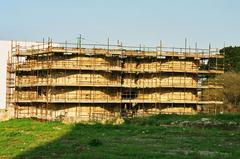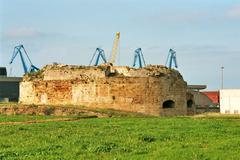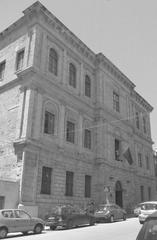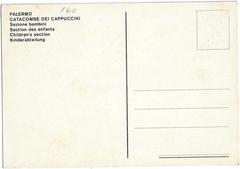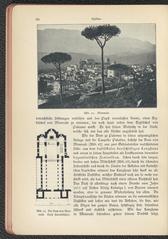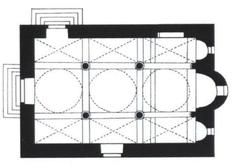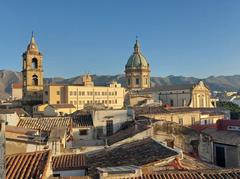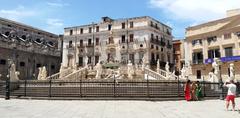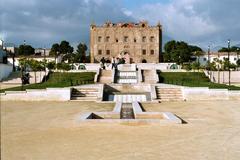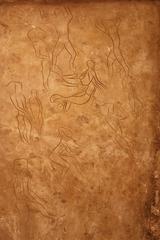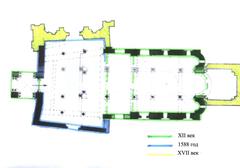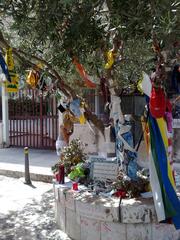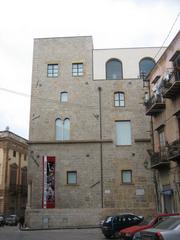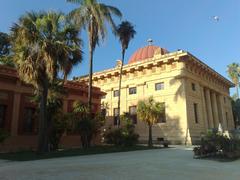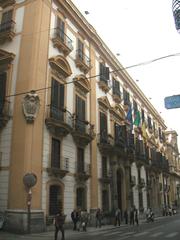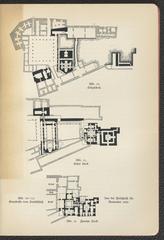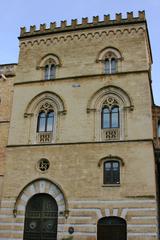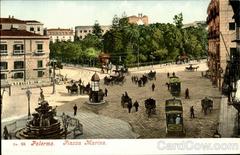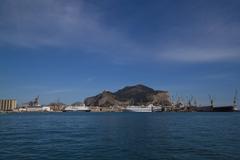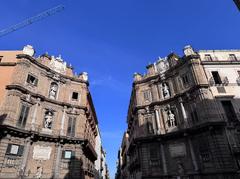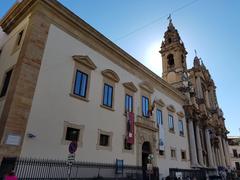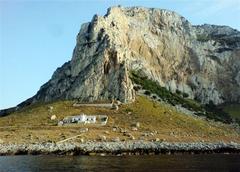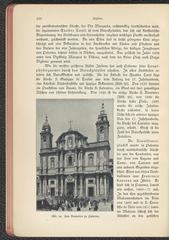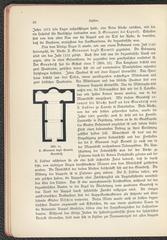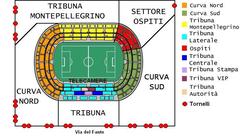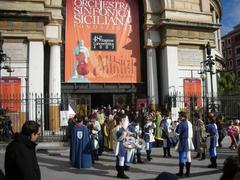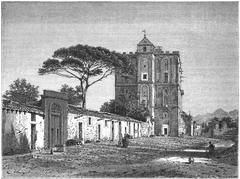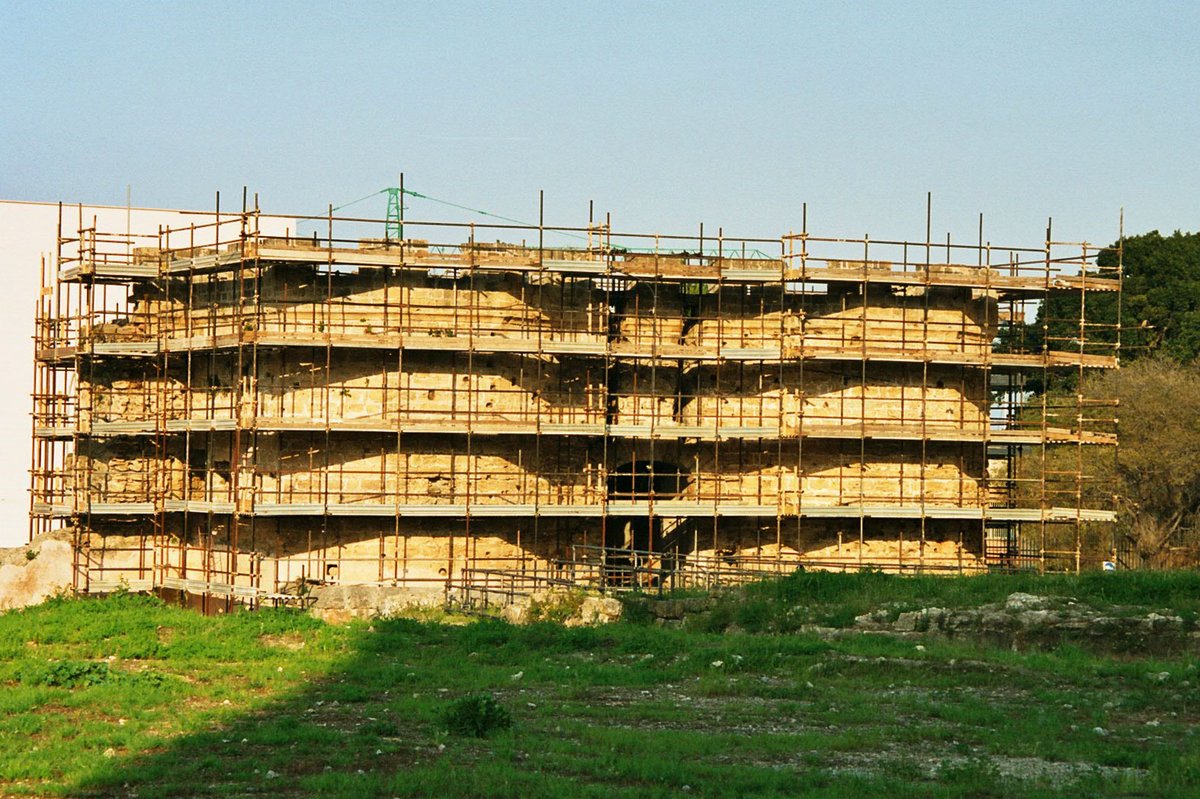
Visiting Hours, Tickets, and Tips for Castello a Mare, Palermo
Date: 31/07/2024
Introduction
Nestled at the entrance to Palermo’s historic port, Castello a Mare, also known as Castellammare, stands as a testament to Sicily’s rich and diverse history. This ancient fortress, with origins dating back to the 9th century, has witnessed the rise and fall of numerous empires, from the Arab-Norman period to the Spanish and Bourbon reigns. Initially constructed to protect the bustling port from naval invasions and pirate attacks, Castello a Mare has evolved over centuries, featuring significant architectural enhancements by the Normans, Spanish, and Renaissance architects. This guide aims to provide a comprehensive overview of Castello a Mare’s historical significance, architectural marvels, and practical information for visitors, making it an indispensable resource for anyone planning to explore one of Palermo’s most iconic landmarks (Wikipedia, Spotting History, GPSmyCity).
Table of Contents
- [Historical Background](#historical-backgroundhistorical-background)
- [Origins and Early History](#origins-and-early-historyorigins-and-early-history)
- [Norman Influence](#norman-influencenorman-influence)
- [Renaissance Modifications](#renaissance-modificationsrenaissance-modifications)
- [Spanish and Bourbon Periods](#spanish-and-bourbon-periodsspanish-and-bourbon-periods)
- [Decline and Rediscovery](#decline-and-rediscoverydecline-and-rediscovery)
- [Architectural Features](#architectural-featuresarchitectural-features)
- [Cultural Significance](#cultural-significancecultural-significance)
- [Visitor Information](#visitor-informationvisitor-information)
- [Visiting Hours and Tickets](#visiting-hours-and-ticketsvisiting-hours-and-tickets)
- [Guided Tours and Apps](#guided-tours-and-appsguided-tours-and-apps)
- [Nearby Attractions](#nearby-attractionsnearby-attractions)
- [FAQ](#faqfaq)
- [Conclusion](#conclusionconclusion)
- [References](#referencesreferences)
Historical Background
Origins and Early History
Castello a Mare, also known as Castellammare, is an ancient fortress located at the entrance to the port of Palermo in La Cala. The origins of the fortress date back to the Arab-Norman period, reflecting the strategic importance of Palermo as a maritime hub. The fortress was initially constructed to protect the port and the city from naval invasions and pirate attacks. The earliest structures of Castello a Mare can be traced back to the 9th century when the Arabs ruled Sicily. During this period, the fortress served as a critical defensive structure, safeguarding the burgeoning trade routes that connected Palermo to the broader Mediterranean world.
Norman Influence
The Norman conquest of Sicily in the 11th century marked a significant transformation for Castello a Mare. Under Norman rule, the fortress was extensively fortified and expanded. The Normans, known for their military prowess and architectural innovations, introduced several enhancements to the fortress. One of the most notable additions was the Norman keep, a robust and imposing structure that served as the central stronghold of the fortress. This keep was designed to withstand prolonged sieges and provided a secure refuge for the defenders (Wikipedia).
Renaissance Modifications
The Renaissance period brought further modifications to Castello a Mare, reflecting the evolving military architecture of the time. During the 16th century, the fortress underwent significant renovations to adapt to advancements in artillery and siege warfare. One of the most remarkable features from this period is the sophisticated star-shaped defense system. This design, characterized by angular bastions and fortified walls, was intended to deflect cannonballs and provide overlapping fields of fire, enhancing the fortress’s defensive capabilities (Spotting History).
Spanish and Bourbon Periods
The Spanish and later Bourbon rulers of Sicily continued to maintain and upgrade Castello a Mare. During the Spanish period, the fortress played a crucial role in the defense of Palermo against various threats, including Ottoman incursions and local uprisings. The Bourbons, who ruled Sicily in the 18th and early 19th centuries, also recognized the strategic importance of the fortress. They implemented further enhancements, including the construction of additional barracks and storage facilities to support a larger garrison.
Decline and Rediscovery
The decline of Castello a Mare began in the 19th century as the fortress lost its military significance. With the advent of modern warfare and the unification of Italy, the fortress was gradually abandoned and fell into disrepair. By the early 20th century, much of the structure was in ruins, and it was largely forgotten by the public. However, the late 20th and early 21st centuries saw a renewed interest in the historical and cultural significance of Castello a Mare. Archaeological excavations and restoration efforts have uncovered extensive remains of the fortress, including the Norman keep, the fortified gate, and the Renaissance star-shaped defenses. Today, these remains are open to the public, offering a glimpse into the rich history of Palermo and its maritime heritage (GPSmyCity).
Architectural Features
The architectural features of Castello a Mare reflect the various historical periods and influences that shaped its development. The Norman keep, with its thick walls and narrow windows, exemplifies the defensive architecture of the medieval period. The Renaissance star-shaped defenses showcase the innovative military engineering of the 16th century. These features include angular bastions designed to withstand artillery fire and provide a strategic advantage to the defenders.
The fortified gate or entrance of Castello a Mare is another notable feature. This gate, constructed during the Norman period, served as the primary access point to the fortress. It was designed to be heavily fortified, with multiple layers of defense to deter attackers. The gate’s architecture reflects the blend of Norman and Arab influences that characterized much of Sicily’s medieval architecture.
Cultural Significance
Castello a Mare holds significant cultural and historical value for Palermo and Sicily. The fortress is a testament to the island’s rich and diverse history, reflecting the various cultures and civilizations that have influenced its development. From the Arab rulers who first established the fortress to the Normans, Spaniards, and Bourbons who expanded and fortified it, Castello a Mare embodies the complex and layered history of Sicily.
The fortress also serves as a symbol of Palermo’s maritime heritage. As a key defensive structure guarding the entrance to the port, Castello a Mare played a crucial role in protecting the city’s trade routes and economic interests. Its strategic location and formidable defenses underscore the importance of Palermo as a major maritime hub in the Mediterranean.
Visitor Information
Visiting Hours and Tickets
Castello a Mare is open to visitors year-round. The visiting hours are typically from 9:00 AM to 7:00 PM, but it’s advisable to check the official website or contact the site directly for the most up-to-date information on opening hours and any seasonal variations. Ticket prices vary, with discounts available for students, seniors, and groups. General admission is usually around €5 for adults, with reduced rates for eligible visitors.
Guided Tours and Apps
Guided tours are available for those who wish to gain a deeper understanding of Castello a Mare’s history and architecture. These tours provide detailed insights into the various phases of the fortress’s development and its cultural significance. For a more flexible experience, self-guided walking tours are available through mobile apps such as “GPSmyCity: Walks in 1K+ Cities,” which can be downloaded from the Apple App Store or Google Play Store. These apps turn mobile devices into personal tour guides, offering detailed information about Castello a Mare and other historical sites in Palermo (GPSmyCity).
Nearby Attractions
While visiting Castello a Mare, consider exploring other nearby attractions in Palermo. The Palermo Cathedral, a stunning example of Norman architecture, is just a short distance away. The bustling Ballarò Market offers a vibrant glimpse into local life and cuisine. Additionally, the Teatro Massimo, one of Italy’s largest opera houses, provides a rich cultural experience with its grand performances and architectural beauty.
FAQ
What are the visiting hours for Castello a Mare? Castello a Mare is typically open from 9:00 AM to 7:00 PM. However, it’s recommended to check the official website or contact the site directly for the most current visiting hours.
How much are tickets to Castello a Mare? General admission is usually around €5 for adults, with discounts available for students, seniors, and groups.
Are guided tours available at Castello a Mare? Yes, guided tours are available and provide detailed insights into the fortress’s history and architecture. Self-guided tours can also be taken using apps like “GPSmyCity.”
What are some nearby attractions to Castello a Mare? Nearby attractions include Palermo Cathedral, Ballarò Market, and Teatro Massimo.
Conclusion
Castello a Mare is a fascinating historical site that offers a unique window into the rich and diverse history of Palermo and Sicily. Its architectural features, cultural significance, and strategic importance make it a must-visit destination for history enthusiasts and tourists alike. Don’t miss the opportunity to explore this remarkable fortress and immerse yourself in Palermo’s maritime heritage (Everything Zany, Cultured Voyages, Palermo for 91 Days, Enjoy Sicilia).
References
- Exploring Castello a Mare: History, Visiting Hours, and Tips for Your Palermo Visit, 2024, Wikipedia Wikipedia
- Exploring Castello a Mare: History, Visiting Hours, and Tips for Your Palermo Visit, 2024, Spotting History Spotting History
- Exploring Castello a Mare: History, Visiting Hours, and Tips for Your Palermo Visit, 2024, GPSmyCity GPSmyCity
- Ultimate Guide to Visiting Castello a Mare: Hours, Tickets, and Tips for Palermo’s Historic Fortress, 2024, Everything Zany Everything Zany
- Ultimate Guide to Visiting Castello a Mare: Hours, Tickets, and Tips for Palermo’s Historic Fortress, 2024, Cultured Voyages Cultured Voyages
- Ultimate Guide to Visiting Castello a Mare: Hours, Tickets, and Tips for Palermo’s Historic Fortress, 2024, Palermo for 91 Days Palermo for 91 Days
- Ultimate Guide to Visiting Castello a Mare: Hours, Tickets, and Tips for Palermo’s Historic Fortress, 2024, Enjoy Sicilia Enjoy Sicilia
